2020届高考英语语法系统复习之代词的考点(共44张ppt)
文档属性
| 名称 | 2020届高考英语语法系统复习之代词的考点(共44张ppt) |  | |
| 格式 | zip | ||
| 文件大小 | 1.4MB | ||
| 资源类型 | 教案 | ||
| 版本资源 | 通用版 | ||
| 科目 | 英语 | ||
| 更新时间 | 2019-11-24 21:34:33 | ||
图片预览


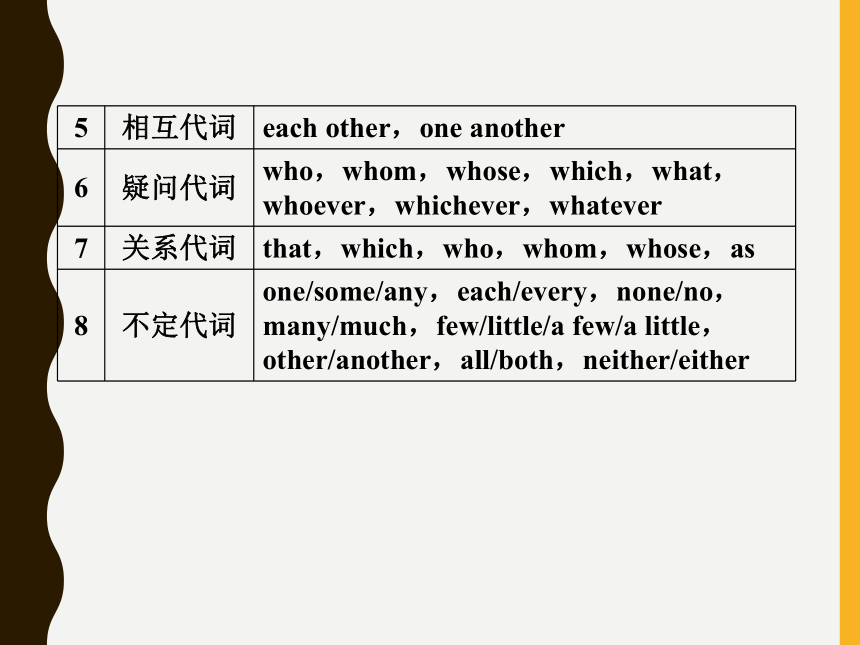
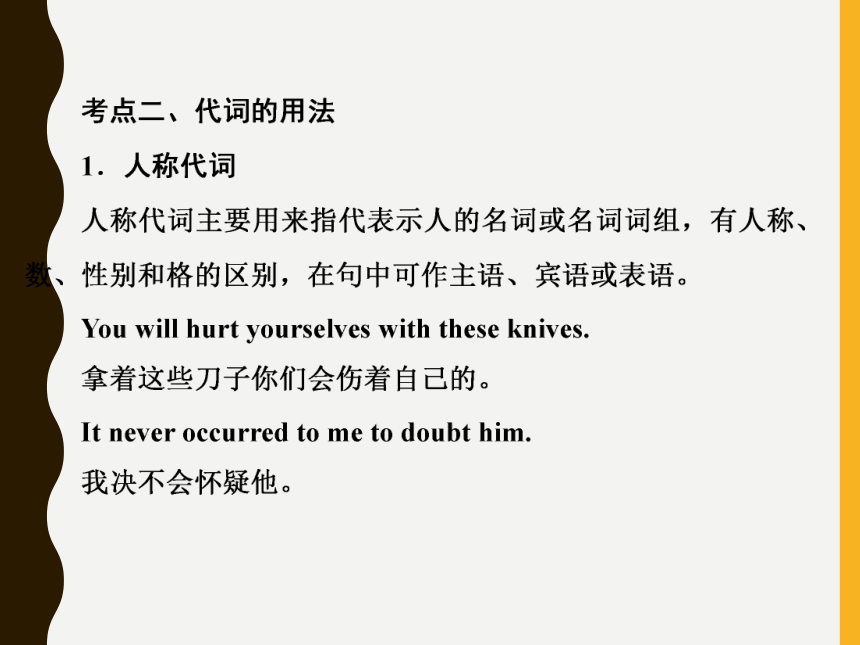
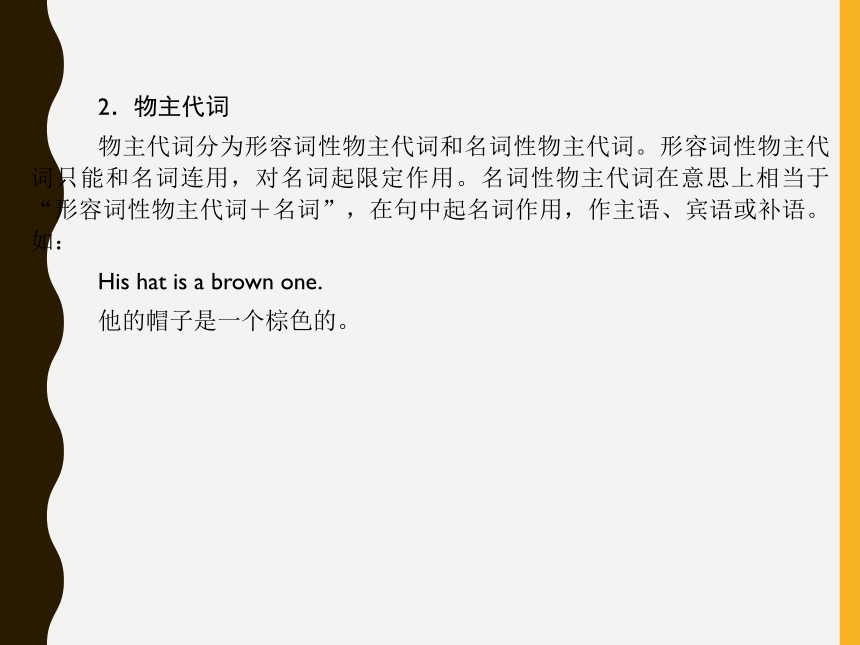

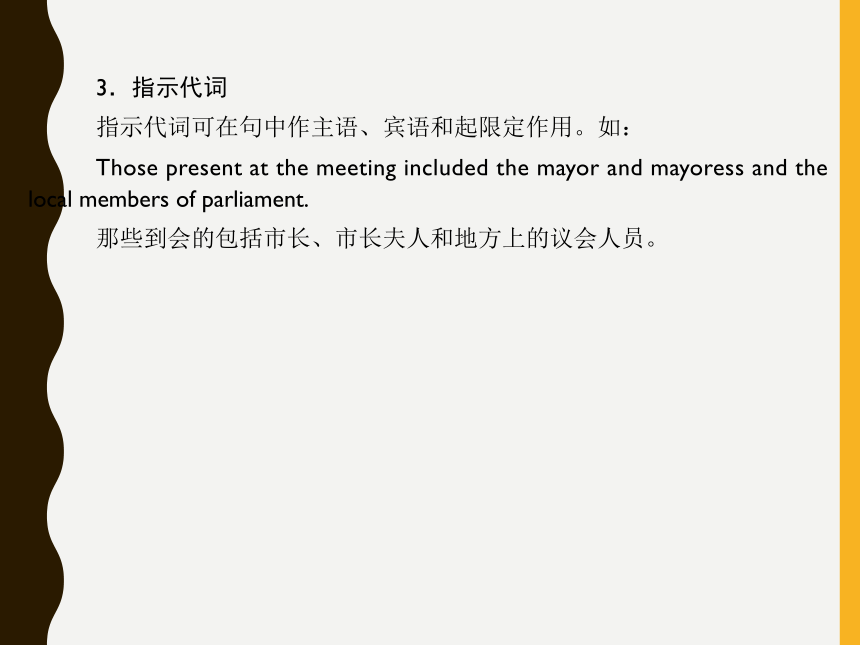


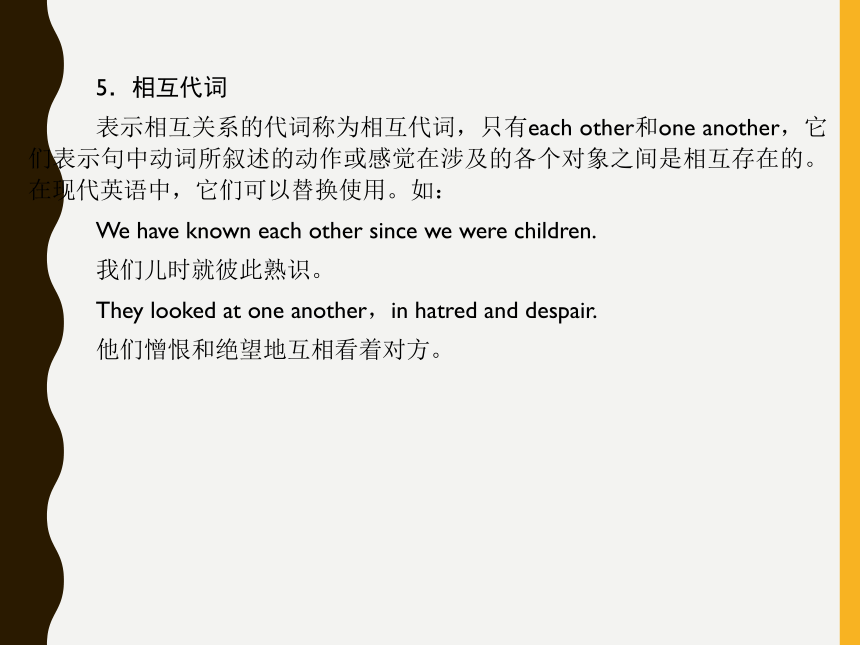

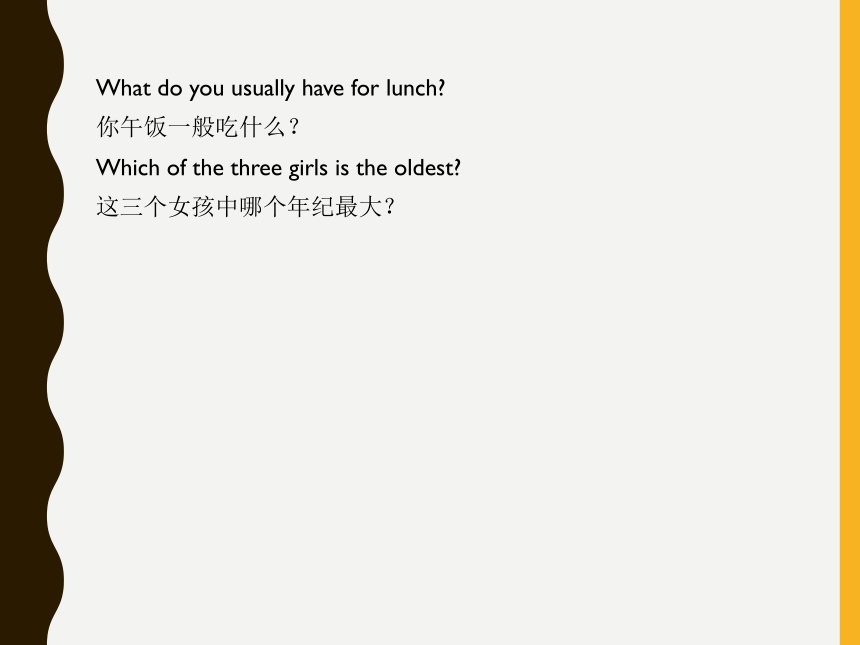
文档简介
(共44张PPT)
2020年高考语法系统复习之代词的考点
1 人称代词 主格 I,you,he,she,it,we,you,they
宾格 me,you,him,her,it,us,you,them
2 物主代词 形容词性 my,your,his,her,its,our,your,their
名词性 mine,yours,his,hers,its,ours,yours,theirs
3 指示代词 this,that,these,those,such,some
4 反身代词 myself,yourself,himself,herself,itself,ourselves,yourselves,themselves
5 相互代词 each other,one another
6 疑问代词 who,whom,whose,which,what,whoever,whichever,whatever
7 关系代词 that,which,who,whom,whose,as
8 不定代词 one/some/any,each/every,none/no,many/much,few/little/a few/a little,other/another,all/both,neither/either
2.物主代词
物主代词分为形容词性物主代词和名词性物主代词。形容词性物主代词只能和名词连用,对名词起限定作用。名词性物主代词在意思上相当于“形容词性物主代词+名词”,在句中起名词作用,作主语、宾语或补语。如:
His hat is a brown one.
他的帽子是一个棕色的。
Her son is a friend of ours.
她的儿子是我们的朋友。
Our school beat theirs at baseball.
在棒球赛中我们学校打赢了他们的学校。
3.指示代词
指示代词可在句中作主语、宾语和起限定作用。如:
Those present at the meeting included the mayor and mayoress and the local members of parliament.
那些到会的包括市长、市长夫人和地方上的议会人员。
—Shall we buy this book or that one?
我们买这本书还是那本?
—I like that one.
我喜欢那本。
Hello.This is Jim. Is that John?
你好,我是吉姆。你是约翰吗?
4.反身代词
反身代词是用后缀?self(复数selves)加上第一人称、第二人称的形容词性物主代词,或者加上第三人称代词的宾格形式构成的。可在句中作宾语、表语或同位语,也可由并列连词连接,与另一词并列作主语。如:
Tom and Ann blamed themselves for the accident.
汤姆和安因这场事故而责备他们自己。
Frank is not quite himself today.
弗兰克今天有些不舒服。
5.相互代词
表示相互关系的代词称为相互代词,只有each other和one another,它们表示句中动词所叙述的动作或感觉在涉及的各个对象之间是相互存在的。在现代英语中,它们可以替换使用。如:
We have known each other since we were children.
我们儿时就彼此熟识。
They looked at one another,in hatred and despair.
他们憎恨和绝望地互相看着对方。
6.疑问代词
疑问代词常用于特殊疑问句中,一般放在句首,并在句中作某一句子成分,可作主语、宾语、表语和定语。疑问代词都可用作连接代词,引导名词性从句(主语从句、宾语从句和表语从句)。如:
Who is going to speak to us tomorrow?
明天谁会来跟我们讲话?
What do you usually have for lunch?
你午饭一般吃什么?
Which of the three girls is the oldest?
这三个女孩中哪个年纪最大?
7.关系代词
关系代词是用来引导形容词性从句的,有主格、宾格和所有格,也有人称和非人称之分。如:
He that would eat the fruit must climb the tree.
谁想吃这种水果必须得爬树。
Tom spent four years in college, during which time he learned French.
汤姆读了四年大学,期间他学习了法语。
8.不定代词
不指明代替任何特定名词的代词叫做不定代词。常见的不定代词有all,both,each,every等,以及含有some?,any?,no?等的合成代词或名词短语,如anybody,something,no one。这些不定代词大都可以代替名词或形容词,在句中作主语、宾语、表语或定语,但none和由some,any,no等构成的复合不定代词只能作主语、宾语或表语;every和no只能作定语。如:
Everything went according to the plan, didn't it?
一切都按计划进行,是吗?
Why not buy some bread?
为什么不买些面包呢?
All of the students are interested in it.
所有的学生对此都很感兴趣。
(2)指代前面所提到过的事物、群体、想法、性别不明或性别被认为不重要的人或动物、未指明但谈话双方都明白的事情或情况。如:
—Who is knocking at the door?
—It's me.
—I've broken a plate.
—It (=Breaking the plate)doesn't matter.(前面所提到过的事情)
(3)it可以用作形式主语或形式宾语,而把真正的主语或宾语放在后面,真正的主语或宾语往往由从句、动名词、不定式充当。如:
I think it necessary that we have the meeting.
我认为开这个会是有必要的。
It is said that all of them have gone to the cinema.
据说他们都去看电影了。
(4)it用在不能直接跟宾语从句的动词,尤其是表示好恶的动词后面,如:enjoy,like,love,dislike,hate,don't mind,be fond of,feel like,see to后,即这些动词后面的宾语从句前要加it。如:
I take it that you don't agree with me.
我的理解是:你不同意我的见解。
I hate it when I have to speak in French on the phone.
有时,非得用法语打电话,我感到很讨厌。
2.both,all,either,any,neither,none的用法
都 任何 都不
两者 both either neither
三者或三者以上 all any none
如:(1)—When shall we meet again?
咱们什么时候再见面?
—Make it any day you like;it's all the same to me.
你喜欢哪天就哪天;对我来说,哪天都无所谓。
(2)—Can you come on Monday or Tuesday?
周一和周二你哪天能来?
—I'm afraid neither day is possible.
恐怕(这两天)哪天都不行。
3.some,any,no与one,body,thing构成的合成词的用法
some,any,no可以与one,body,thing构成合成代词。和some,any一样,somebody等词一般用于肯定句,anybody等词一般用于否定句、疑问句及条件从句。somebody等词表示请求、建议或反问等语气时,也可用于疑问句。nothing和nobody表示全部否定。无论在肯定句、否定句还是疑问句中,everything,everyone和everybody都表示“全部,所有”。
当先行词为everyone,everybody,nobody,anyone,anybody,someone,somebody等复合词时,需用代词指代或相应的限定词修饰时,通常按照语法一致原则用单数形式,但在非正式语体中,也可根据意义一致的原则用复数形式。如:
Make sure you get everything ready before you leave.
你离开前一定要把一切准备好。
Anybody can attend the meeting.
任何人都可以参加这个会议。
Someone left their umbrella behind yesterday.
昨天有人忘了带伞。
4.every,each的用法
each强调“个体”,既可作代词又可作形容词,指“两个或两个以上中的每一个”;every强调“全体”,只能作定语,指“三个或三个以上中的每一个”。each作主语时谓语动词用单数形式,作同位语时,谓语动词的数要和主语一致,如:
There are trees on each side of the road.
路的两边都有树。
Every student has to take the examination.
=All the students have to take the examination.
每个学生都必须参加考试。
5.全部否定与部分否定
none,no one,nobody,nothing,neither,not any以及no+名词均表示全部否定;但当not出现在含有表示肯定的不定代词的句子中时,not在其前或其后都表示部分否定。例如:
Both of us are not teachers.
我们俩不都是老师。(部分否定)
Neither of us is a teacher.
我们俩都不是老师。(全部否定)
All of the books are not English books.(或Not all of the books are English books.)
这些书不都是英语书。(部分否定)
None of the books are English books.
所有的书都不是英语书。(全部否定)
6.other,another,the other,others,the others
(1)other作前置定语,表示“另外的”。如:
We study Chinese,maths,English and other lessons.
我们学习语文、数学、英语和其他课程。
(2)another用于泛指三者以上的不定数目中的“另一个”。用于单数可数名词前。如:
I don't want this bag.Please give me another one.
我不想要这个包。请给我另一个。
(3)the other表示两者中的“另一个”或两部分中的“另一部分”,是特指。如:
There are six people in the room.Four are girls, the other two are boys.
房间里有六个人。四个是女孩,其余的两个是男孩。
(4)others作代词,泛指“其他人”或“其他物”。如:
Some are singing and dancing,some are drawing,others are climbing the hill.
一些人在唱歌跳舞,一些人在画画,还有一些人在爬山。
(5)the others指整体中除去一部分后,剩余的全部。如:
Of the six,one went home,and the others went to the cinema.
六个人中,一个人回家了,其余(五个人)去看电影了。
7.one,ones,the one,the ones,that,those的用法
one用来替代前面出现的单数名词,是泛指概念,相当于a/an+单数名词;ones用来替代前面出现的复数名词,也是泛指概念;the one用来替代前面的特指的单数名词,有时可用that替代(尤其在有后置定语的情况下);the ones用来替代前面的特指的复数名词,有时可用those替代(尤其在有后置定语的情况下);that用来替代前面出现的特指的单数可数名词或特指的不可数名词,相当于the+单数/不可数名词。
如:
The books on the desk are better than those/the ones(=the books)under the desk.
桌子上的书要比桌子下面的好。
Few pleasures can equal that(=the pleasure)of a cool drink on a hot day.
没有什么能比得上在炎热的天气里喝上一杯冷饮那样快乐。
—Why don't we take a little break?
我们为何不稍微休息一下?
—Didn't we just have one(=a break)?
我们不是刚休息了吗?
Here are six rings.Pick out the one you like best.
这里有六枚戒指。选出你最喜欢的一枚。
Students who do well in examinations are those/the ones who ask questions in class.
考试成绩好的都是上课爱提问的学生。
8.与复合不定代词构成的习惯句型
He is nothing but a clerk.
他只是一个职员。
He is anything but a clerk.
他绝不是一名职员。
He is someone/something.
他是一个重要人物/出色的人物。
例如:
—He found a baby in his car when he came back from the supermarket.And________was crying for some milk.
—When was________?
—________was in 2000 when he was still in college.
A.it;that;This B.he;this;It
C.she;it;This D.it;that;It
[解析]句意:——他从超市出来后发现车里有个婴儿,正在哭着要奶吃。——那是什么时候?——是2000年,当时他仍在上大学。第一个空用it指代上面提到的婴儿。第二个空表示上面提到的事情,所以用that或者it替代;第三个空是强调句式结构的省略,应该使用it,完整的强调句是:It was in 2000 when he was still in college that he found a baby in his car.
[答案]D
2.理解名词特点,正确使用替代词
在一个句子中,当一个名词再次出现在句子中时,为了避免重复,往往用替代词来代替它。one替代单数可数名词,表示泛指,相当于“a(an)+单数可数名词”,其复数形式是ones。that替代前面出现的特指的单数可数名词或者不可数名词,相当于“the+单数可数名词/不可数名词”,that后一般有限定成分,其复数形式是those。例如:
This planet's position may be similar to________of Earth,but its environment is more like a vision of hell.
A.that B.it
C.one D.this
[解析]此句中that代替前面提到的position。that代替不可数名词或单数可数名词,所指代的名词与前面提到的名词是一类。it代替同名同物;one代替单数可数名词,表示同名异物。
[答案]A
3.体会数量概念,区分不定代词
some,any,every常与?one,?body,?thing构成复合不定代词,其基本用法与some,any,every用法相当,在句子中用法非常灵活。表示否定意义的不定代词容易混淆,特别要注意nothing和none的区别。
例如:
—Do you have the Harry Potter books by J.K. Rowling in your shop?
—Sorry,there is ________left at the moment.
A.nothing B.no one
C.none D.not one
[解析]none“没人,没有任何东西”,既可指人,也可指物。none后可接of短语,强调数的概念,指具体的人或物,常用来回答how many/much引导的疑问句;no one表示“没有人,谁也不”,只指人,作主语时,谓语动词用单数,常可用来回答who引导的问句;nothing“什么也没有,没什么东西”,只用来指物,并且不能用来指单个的东西,也不能用来指具体的东西,常用来回答what引导的问句,作主语时,谓语用单数。此题中none指not a book。
[答案]C
Practice Makes Perfect!!
2020年高考语法系统复习之代词的考点
1 人称代词 主格 I,you,he,she,it,we,you,they
宾格 me,you,him,her,it,us,you,them
2 物主代词 形容词性 my,your,his,her,its,our,your,their
名词性 mine,yours,his,hers,its,ours,yours,theirs
3 指示代词 this,that,these,those,such,some
4 反身代词 myself,yourself,himself,herself,itself,ourselves,yourselves,themselves
5 相互代词 each other,one another
6 疑问代词 who,whom,whose,which,what,whoever,whichever,whatever
7 关系代词 that,which,who,whom,whose,as
8 不定代词 one/some/any,each/every,none/no,many/much,few/little/a few/a little,other/another,all/both,neither/either
2.物主代词
物主代词分为形容词性物主代词和名词性物主代词。形容词性物主代词只能和名词连用,对名词起限定作用。名词性物主代词在意思上相当于“形容词性物主代词+名词”,在句中起名词作用,作主语、宾语或补语。如:
His hat is a brown one.
他的帽子是一个棕色的。
Her son is a friend of ours.
她的儿子是我们的朋友。
Our school beat theirs at baseball.
在棒球赛中我们学校打赢了他们的学校。
3.指示代词
指示代词可在句中作主语、宾语和起限定作用。如:
Those present at the meeting included the mayor and mayoress and the local members of parliament.
那些到会的包括市长、市长夫人和地方上的议会人员。
—Shall we buy this book or that one?
我们买这本书还是那本?
—I like that one.
我喜欢那本。
Hello.This is Jim. Is that John?
你好,我是吉姆。你是约翰吗?
4.反身代词
反身代词是用后缀?self(复数selves)加上第一人称、第二人称的形容词性物主代词,或者加上第三人称代词的宾格形式构成的。可在句中作宾语、表语或同位语,也可由并列连词连接,与另一词并列作主语。如:
Tom and Ann blamed themselves for the accident.
汤姆和安因这场事故而责备他们自己。
Frank is not quite himself today.
弗兰克今天有些不舒服。
5.相互代词
表示相互关系的代词称为相互代词,只有each other和one another,它们表示句中动词所叙述的动作或感觉在涉及的各个对象之间是相互存在的。在现代英语中,它们可以替换使用。如:
We have known each other since we were children.
我们儿时就彼此熟识。
They looked at one another,in hatred and despair.
他们憎恨和绝望地互相看着对方。
6.疑问代词
疑问代词常用于特殊疑问句中,一般放在句首,并在句中作某一句子成分,可作主语、宾语、表语和定语。疑问代词都可用作连接代词,引导名词性从句(主语从句、宾语从句和表语从句)。如:
Who is going to speak to us tomorrow?
明天谁会来跟我们讲话?
What do you usually have for lunch?
你午饭一般吃什么?
Which of the three girls is the oldest?
这三个女孩中哪个年纪最大?
7.关系代词
关系代词是用来引导形容词性从句的,有主格、宾格和所有格,也有人称和非人称之分。如:
He that would eat the fruit must climb the tree.
谁想吃这种水果必须得爬树。
Tom spent four years in college, during which time he learned French.
汤姆读了四年大学,期间他学习了法语。
8.不定代词
不指明代替任何特定名词的代词叫做不定代词。常见的不定代词有all,both,each,every等,以及含有some?,any?,no?等的合成代词或名词短语,如anybody,something,no one。这些不定代词大都可以代替名词或形容词,在句中作主语、宾语、表语或定语,但none和由some,any,no等构成的复合不定代词只能作主语、宾语或表语;every和no只能作定语。如:
Everything went according to the plan, didn't it?
一切都按计划进行,是吗?
Why not buy some bread?
为什么不买些面包呢?
All of the students are interested in it.
所有的学生对此都很感兴趣。
(2)指代前面所提到过的事物、群体、想法、性别不明或性别被认为不重要的人或动物、未指明但谈话双方都明白的事情或情况。如:
—Who is knocking at the door?
—It's me.
—I've broken a plate.
—It (=Breaking the plate)doesn't matter.(前面所提到过的事情)
(3)it可以用作形式主语或形式宾语,而把真正的主语或宾语放在后面,真正的主语或宾语往往由从句、动名词、不定式充当。如:
I think it necessary that we have the meeting.
我认为开这个会是有必要的。
It is said that all of them have gone to the cinema.
据说他们都去看电影了。
(4)it用在不能直接跟宾语从句的动词,尤其是表示好恶的动词后面,如:enjoy,like,love,dislike,hate,don't mind,be fond of,feel like,see to后,即这些动词后面的宾语从句前要加it。如:
I take it that you don't agree with me.
我的理解是:你不同意我的见解。
I hate it when I have to speak in French on the phone.
有时,非得用法语打电话,我感到很讨厌。
2.both,all,either,any,neither,none的用法
都 任何 都不
两者 both either neither
三者或三者以上 all any none
如:(1)—When shall we meet again?
咱们什么时候再见面?
—Make it any day you like;it's all the same to me.
你喜欢哪天就哪天;对我来说,哪天都无所谓。
(2)—Can you come on Monday or Tuesday?
周一和周二你哪天能来?
—I'm afraid neither day is possible.
恐怕(这两天)哪天都不行。
3.some,any,no与one,body,thing构成的合成词的用法
some,any,no可以与one,body,thing构成合成代词。和some,any一样,somebody等词一般用于肯定句,anybody等词一般用于否定句、疑问句及条件从句。somebody等词表示请求、建议或反问等语气时,也可用于疑问句。nothing和nobody表示全部否定。无论在肯定句、否定句还是疑问句中,everything,everyone和everybody都表示“全部,所有”。
当先行词为everyone,everybody,nobody,anyone,anybody,someone,somebody等复合词时,需用代词指代或相应的限定词修饰时,通常按照语法一致原则用单数形式,但在非正式语体中,也可根据意义一致的原则用复数形式。如:
Make sure you get everything ready before you leave.
你离开前一定要把一切准备好。
Anybody can attend the meeting.
任何人都可以参加这个会议。
Someone left their umbrella behind yesterday.
昨天有人忘了带伞。
4.every,each的用法
each强调“个体”,既可作代词又可作形容词,指“两个或两个以上中的每一个”;every强调“全体”,只能作定语,指“三个或三个以上中的每一个”。each作主语时谓语动词用单数形式,作同位语时,谓语动词的数要和主语一致,如:
There are trees on each side of the road.
路的两边都有树。
Every student has to take the examination.
=All the students have to take the examination.
每个学生都必须参加考试。
5.全部否定与部分否定
none,no one,nobody,nothing,neither,not any以及no+名词均表示全部否定;但当not出现在含有表示肯定的不定代词的句子中时,not在其前或其后都表示部分否定。例如:
Both of us are not teachers.
我们俩不都是老师。(部分否定)
Neither of us is a teacher.
我们俩都不是老师。(全部否定)
All of the books are not English books.(或Not all of the books are English books.)
这些书不都是英语书。(部分否定)
None of the books are English books.
所有的书都不是英语书。(全部否定)
6.other,another,the other,others,the others
(1)other作前置定语,表示“另外的”。如:
We study Chinese,maths,English and other lessons.
我们学习语文、数学、英语和其他课程。
(2)another用于泛指三者以上的不定数目中的“另一个”。用于单数可数名词前。如:
I don't want this bag.Please give me another one.
我不想要这个包。请给我另一个。
(3)the other表示两者中的“另一个”或两部分中的“另一部分”,是特指。如:
There are six people in the room.Four are girls, the other two are boys.
房间里有六个人。四个是女孩,其余的两个是男孩。
(4)others作代词,泛指“其他人”或“其他物”。如:
Some are singing and dancing,some are drawing,others are climbing the hill.
一些人在唱歌跳舞,一些人在画画,还有一些人在爬山。
(5)the others指整体中除去一部分后,剩余的全部。如:
Of the six,one went home,and the others went to the cinema.
六个人中,一个人回家了,其余(五个人)去看电影了。
7.one,ones,the one,the ones,that,those的用法
one用来替代前面出现的单数名词,是泛指概念,相当于a/an+单数名词;ones用来替代前面出现的复数名词,也是泛指概念;the one用来替代前面的特指的单数名词,有时可用that替代(尤其在有后置定语的情况下);the ones用来替代前面的特指的复数名词,有时可用those替代(尤其在有后置定语的情况下);that用来替代前面出现的特指的单数可数名词或特指的不可数名词,相当于the+单数/不可数名词。
如:
The books on the desk are better than those/the ones(=the books)under the desk.
桌子上的书要比桌子下面的好。
Few pleasures can equal that(=the pleasure)of a cool drink on a hot day.
没有什么能比得上在炎热的天气里喝上一杯冷饮那样快乐。
—Why don't we take a little break?
我们为何不稍微休息一下?
—Didn't we just have one(=a break)?
我们不是刚休息了吗?
Here are six rings.Pick out the one you like best.
这里有六枚戒指。选出你最喜欢的一枚。
Students who do well in examinations are those/the ones who ask questions in class.
考试成绩好的都是上课爱提问的学生。
8.与复合不定代词构成的习惯句型
He is nothing but a clerk.
他只是一个职员。
He is anything but a clerk.
他绝不是一名职员。
He is someone/something.
他是一个重要人物/出色的人物。
例如:
—He found a baby in his car when he came back from the supermarket.And________was crying for some milk.
—When was________?
—________was in 2000 when he was still in college.
A.it;that;This B.he;this;It
C.she;it;This D.it;that;It
[解析]句意:——他从超市出来后发现车里有个婴儿,正在哭着要奶吃。——那是什么时候?——是2000年,当时他仍在上大学。第一个空用it指代上面提到的婴儿。第二个空表示上面提到的事情,所以用that或者it替代;第三个空是强调句式结构的省略,应该使用it,完整的强调句是:It was in 2000 when he was still in college that he found a baby in his car.
[答案]D
2.理解名词特点,正确使用替代词
在一个句子中,当一个名词再次出现在句子中时,为了避免重复,往往用替代词来代替它。one替代单数可数名词,表示泛指,相当于“a(an)+单数可数名词”,其复数形式是ones。that替代前面出现的特指的单数可数名词或者不可数名词,相当于“the+单数可数名词/不可数名词”,that后一般有限定成分,其复数形式是those。例如:
This planet's position may be similar to________of Earth,but its environment is more like a vision of hell.
A.that B.it
C.one D.this
[解析]此句中that代替前面提到的position。that代替不可数名词或单数可数名词,所指代的名词与前面提到的名词是一类。it代替同名同物;one代替单数可数名词,表示同名异物。
[答案]A
3.体会数量概念,区分不定代词
some,any,every常与?one,?body,?thing构成复合不定代词,其基本用法与some,any,every用法相当,在句子中用法非常灵活。表示否定意义的不定代词容易混淆,特别要注意nothing和none的区别。
例如:
—Do you have the Harry Potter books by J.K. Rowling in your shop?
—Sorry,there is ________left at the moment.
A.nothing B.no one
C.none D.not one
[解析]none“没人,没有任何东西”,既可指人,也可指物。none后可接of短语,强调数的概念,指具体的人或物,常用来回答how many/much引导的疑问句;no one表示“没有人,谁也不”,只指人,作主语时,谓语动词用单数,常可用来回答who引导的问句;nothing“什么也没有,没什么东西”,只用来指物,并且不能用来指单个的东西,也不能用来指具体的东西,常用来回答what引导的问句,作主语时,谓语用单数。此题中none指not a book。
[答案]C
Practice Makes Perfect!!
